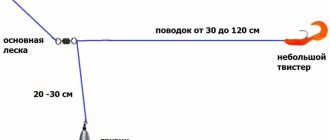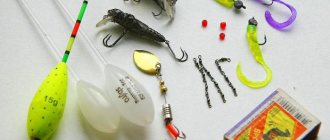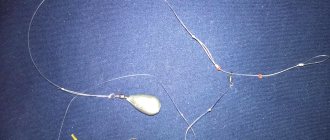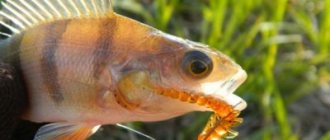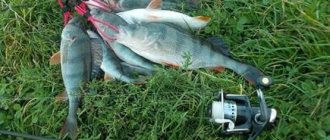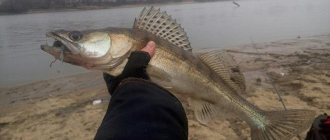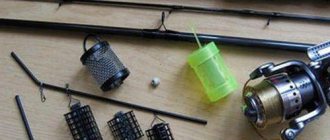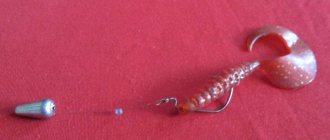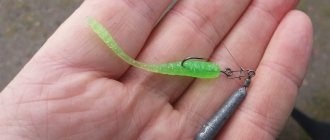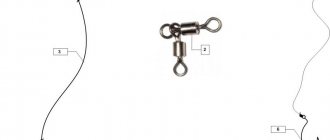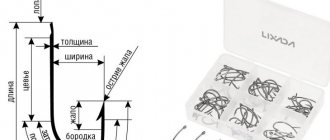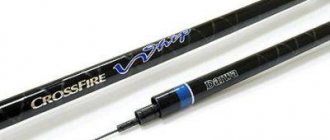Mounting options
Solid installation
This is the simplest installation, when the load is attached to the end of the main line, and above it, at a distance of 20-30 cm, a loop is formed, to which a leash with a hook is attached.
More complex ways
The design of securing the load and leashes can be modified. A double swivel is attached above the secured load. The leash is attached to this swivel.
Alternatively, you can attach a triple swivel so that the main line, leader and sinker are attached to each eye of each swivel. This is not a bad option, especially if you have to fish in the current. The presence of swivels prevents the equipment from twisting, and if it gets caught, you can lose one thing.
Sliding installation
This installation is a mirror image of the previous one, since a leash is attached to the main line, and the weight is located on a separate leash, which slides along the main line. The length of the leash is selected within 20-30 cm. To do this, you need to take the swivel and place it on the main fishing line. A leash is attached to the same swivel, at the end of which another swivel is attached, to which a load is connected. On the main line, below the swivel attachment point, you need to install a stopper.
This installation method allows you to swap the load and the leash. And yet, such equipment has its drawbacks: when casting, the load will always fly first. To limit the sliding of the load along the fishing line, install another stopper above the attachment point.
How to make a diverting leash. Catching equipment
How to make feeder equipment with an anti-twist
Considering that installing a feeder with an anti-twist does not cause any particular difficulties in manufacturing, even a beginner can do it. It is with its use that it is often recommended that beginners begin their acquaintance. There are several ways to create such a montage. Easy way:
- Pass the main line through the cavity of the tube.
- Bring the end of the vein through the short arm of this kind of rocker, releasing the free end 5–7 cm long.
- Place a damper bead on the fishing line, securing a small swivel. Thanks to the installation of a damper, it will be possible to limit and protect the unit when casting the tackle. When the feeder is delivered to the fishing point, the equipment moves along the line and creates pressure on the swivel.
- Attach the leash to the swivel according to the specific fishing conditions.
- Attach the feed container to the carabiner, which is located at the bending point of the anti-twist.
Another installation option:
- Pull monofilament with a cross-section of 0.3-0.4 mm through the cavity of the tube. The output should be veins 7–10 cm long hanging from both ends.
- Place damper beads on the stops.
- Tie the swivels.
- Place the feed container on the short arm.
- Attach a leash to the long part of the anti-twist.
- Mount the structure to the main line through the carabiner located at the bend.
Often, experienced fishermen replace the fishing line with feedergam or hat elastic, which allows the use of thinner reins. There is one nuance here - the degree of installation sensitivity is significantly reduced. But at the same time there is every chance of catching trophy specimens, cautious individuals.
Elements of the diverter leash equipment
Spinning
Such equipment is characterized by the fact that the bait is always in a suspended state and it is difficult to control its play. In this case, it is necessary to have a very sensitive rod with a fast action. Only with the help of such a rod can you understand how the bait behaves.
If fishing is carried out from a boat, then a rod with a length of 2 to 2.4 meters is sufficient. When fishing from the shore, it is better to take a rod up to 2.7 meters long. The spinning test is selected depending on the fishing conditions, or more precisely on the weight of the load. If there is a current, then you will need a solid load, weighing up to 70 grams, or even more. Accordingly, the rod test is selected.
It is advisable that the weight of the rod be minimal, otherwise you will not get any pleasure from the fishing process. This is due to the fact that fishing with a spinning rod requires constant monitoring of the gear. This means that the rod is constantly in the hands of the spinner. A rod that is too heavy will quickly lead to arm fatigue.
Coil
The reel for the tackle is selected depending on the size and characteristics of the fishing rod. There are no special requirements for it. The main thing is that the reel is reliable and can withstand constant casting.
Main line
It is advisable to use braided fishing line, as it does not stretch and will be able to transmit the slightest bites to the tip of the rod. Its diameter depends on many factors, such as the presence of a current, the weight of the load, and the size of the catch. When fishing in the current, it is better to opt for braided line. It is stronger, which means you can use a fishing line with a smaller diameter to create less resistance to the flow.
Leash
Retractable leash (Moscow equipment)
To make a leash, you can take regular monofilament fishing line. Its breaking load should be less than the breaking load of the main line. This is necessary so that in case of a snag you do not have to lose your equipment.
At the same time, it should be remembered that monofilament fishing line has memory, so it is used for one time only. For your next fishing trip, it is advisable to tie the leashes using fresh fishing line.
Recently, almost all anglers have been using fluorocarbon as a leash. It is not visible to fish in the water, and it is somewhat stiffer than monofilament, which leads to less overlap during casting.
The size of the leash for the load is 20 or 30 cm, the size of the leash with a hook is from 50 to 150 cm. Its diameter is selected in the range of 0.16-0.2 mm. If there is a high probability of a pike biting, then it is better to put a metal leash.
Silicone baits
Lures can be made from regular or edible silicone, into which attractants are introduced during its production. The choice of such baits is so large that it is difficult to settle on just one choice. The use of edible rubber is especially important when fishing for perch. In general, if there is a choice, it is better to give preference to edible rubber.
Hook
When using equipment with a retractable leader, the same hooks are used as when fishing with a jig. If the bottom is clean, then you can use ordinary hooks that have a long shank. If there is a possibility of snagging, then it is better to take offset hooks and mount non-snagging hooks.
Fishing with a retractable leash (wiring)
The diverter leash for pike perch, pike and perch works according to the same scheme and there is no difference in their structure.
When fishing from the shore, most often the equipment is thrown to the maximum distance. In this case, it is advisable to take into account the nature of the bottom and avoid fishing in highly snug places, since the entire fishing process involves tapping the bottom with a sinker, followed by a meter-long leash with bait.
After the bait falls into the water, wait until it reaches the bottom; with the line taut at the tip of the rod, you will feel a weakening - it’s time to make a small reel. Rewinding can occur either slowly or quickly, but with stops. Most often this is 2-4 turns of the coil and stopping for a few seconds.
During stops, your line should be taut and if a bite occurs, hook it immediately. The pike perch has a very strong jaw, which cannot be caught with a light hook.
During retrieving between pauses, you can play with the tip of the rod, thereby giving even greater vibration to your bait.
See how a professional fisherman wires a lead rig with a twister.
A retractable leash is more promising than standard jig tackle in that the likelihood of the bait getting caught is much lower, because it is more often in the water and not on the bottom. The action of the bait is also not constrained by a heavy load.
You can use several baits and several leashes in a rig. The next leashes should be shorter than 1 meter and located at a relative distance from the first one so as not to catch each other.
The success of fishing greatly depends on correct wiring. In bad weather, sluggish fish prefer slow-moving prey, take this into account.
Comments
Is it possible to catch pike this way? and what test is needed for a spinning rod?? and what is better to use fishing line or thread?
The spinning rod test should be 40-120 grams and it is better to use braid.
Will regular silicone with a jig work?
For fishing with a retractable leash, it is better to use braided line, since fishing takes place at depth and you need to tap the bottom with a weight. No stretching is very important here.
I don’t know what you mean by ordinary silicone. Twisters and vibrating tails without a jig head are suitable. It is still better to use a weight in the form of a pear or a tube (without a hook, of course) - so that there are no snags.
thanks a lot !! and one more question!! but what if the pike walks on the surface??how to do the wiring??
and another question: if the reservoir is no more than 25 cm, is it possible to fish there?
If the depth is shallow, then a diverting leash is not needed here - use wobblers, ranoutrom.com/sposoby-lovli/shhuka/rybalka-na-voblery.html here is about choosing wobblers for pike and correct wiring.
If you are sure that there is a pike in the reservoir, then you can catch it.
The spinning test primarily depends on the size of the bait. In principle, from 15 to 40 is quite good for a lead and jig fishing. Naturally, you can catch pike. Take only larger baits and experiment with colors. In one weather and place it will be taken with dark or natural colors, on another day and in another place - with fluorescent baits.
Do you need a carbine for a silicone fish? (regular) or should it not spin?
Alexander, do you mean vibrotail? It is better to use a swivel, especially when fishing with a twister. Without a swivel, the equipment will still twist, regardless of how the vibrating tail behaves in the water.
It is better to install a three-way swivel in the place where the diverter leash is attached - there will be less confusion.
And if you put small carbines everywhere, then the tackle turns into an easily dismountable and easily transportable option. Plus, if you are fishing for perch, try a small unshipped perch spinner instead of silicone...also a cool option.
I read a lot of good advice. Thanks for the detailed descriptions. Happy fishing everyone. Ladoga)))
And what kind of lures are needed for catching pike, I used all the wobblers but none of them helped. Young man, help me and tell me how and what bait I should use to catch this pike. Help.
Great info, thanks a lot
I fish with edible rubber, it’s a little expensive, but it all pays off with interest...
Oleg, why is this here?
I do the installation as follows: the main one, put the smallest swivel on it in one ear, then the same swivel in both ears of the main one, two turns each so that it slides along the main one with a weight at the end
When fishing, the swivel moves towards the leash, respectively, thereby also reducing the risk of getting caught in the load and losing the trophy. I only use monofilament. The river has 70-90 meters of driftwood. I carry a kilo of weights and bait with me. But the result is not bad at times.
It can be done easier by using float stop beads, two or three pieces in a row, depending on the expected size of the fish when biting. Then, when hooking, the leash moves towards the sinker and the fishing process improves significantly.
What is the best way to catch herring?
Retractable leash catcher when the sinker walks along the main line
Very informative, thanks to the author! I tried a retractable leash in the summer, it is much more effective than a jig in terms of the number of fish. Have you tried fishing with a retractable leash in late autumn, or even in autumn at all, will it bite?
I fished with a leash from May to November, catchy and simple tackle, and edible rubber on the underwater increases the number of bites.
I catch Bass using all sorts of perch methods...thanks for the advice...Perch or Bass stopped biting in November, maybe a retractable leash will help...we'll try! !!
I didn’t catch any bass, but the perch pecked until the ice on the outlet.
I want to see how they fish with a wobbler on the lake and a sinker
The pace of twitching is preferably fast, and its use is justified in the case of searching for an active predator. Fishing with this type of fishing is aimed at active fish. Therefore, if several individuals are tempted by twitching in one place, it is worth catching in the same place with other wiring options with a different animation. This will allow you to pull out the maximum number of fish from one point.
Types of sinkers
The rig can use various forms of sinkers, depending on the nature of the bottom of the reservoir.
Bullet
This type of sinker is quite similar to a bullet. Under certain conditions, the bullet can withstand most hooks.
Drop shot
This is a special type of sinker designed specifically for drop shot rigs. This is an elongated weight, to the end of which a fishing line is attached. A special type of fastening allows you to very quickly increase or decrease the distance to the hook.
Tyrolean stick
In such a rig, a Tyrolean stick can serve as a load. This is a hollow tube, at one end of which a load is attached, and the other end is hermetically sealed and serves as a fastening for the fishing line. Once in the water, it takes on a vertical position, as a result of which its permeability increases. This factor also helps to reduce the number of hooks and hold the bait at a certain height from the bottom. The technique of fishing with a Tyrolean stick is very unique and requires certain skills. And, nevertheless, the Tyrolean stick is quite catchy.
Long
Here the weight is pear-shaped, which allows you to throw the bait quite far. Carp anglers very often use a load of this shape.
What kind of fish are caught?
Fishing with a spinning rod on a retractable leash helps to have almost the entire list of predatory fish in your trophies. Depending on the use of different types of bait, its size and the implementation of a certain wiring technique, perch, pike perch, pike, asp, catfish and many types of salmon fish are caught with this type of spaced equipment. By-catch often includes bream, ide, chub and carp, which mostly respond to a sample of silicone bait. A wide selection of fishing sites suitable for the method brings solid results in both the quantitative and qualitative composition of the catch.
Important! It is especially worth noting that for pike fishing it is necessary to take into account the additional installation of a metal or Kevlar leash, preventing guaranteed cuts of the nylon thread.
Lures
The main type of bait that is ideal for fishing with a retractable leash is considered to be silicone. There is a huge selection, depending on color, size and purpose. The most suitable are twisters, vibrotails, worms and fish. Although it is possible to use other baits that imitate various crustaceans, bugs, etc. Recently, silicone baits have been used so widely that it seems as if other baits do not exist.
Sometimes, but very rarely, light, rotating or oscillating spoons are used. Equipment with a retractable leash involves the use of very light baits, so spoons and spinners are practically not practiced. It is practiced to use artificial baits such as flies, which have minimal weight, which allows them to be suspended in the water column. Moreover, you can catch any fish with flies, not just predatory ones.
Advantages and disadvantages of fishing with a retractable leash
Advantages:
- The tackle can be thrown over a long distance.
- Good bait play in the current.
- Possibility to fish a reservoir in a targeted manner, because the bait plays itself.
- When attacking a bait, the fish does not feel the weight of the jig head.
- You can catch it by trolling.
- A good way to catch a predator at depth.
- Wind does not affect casting.
- Good sensitivity of the gear.
- Most types of bait can be used.
Flaws:
- The tackle may overlap.
- Sometimes there are false signals in places with strong currents.
- The rig is only effective on an inactive predator due to the slow retrieve.
Interesting: How to properly bait bait so that it looks realistic in the water and attracts pike.
Methods for attaching a leash
There are several options for attaching the leash to the equipment. For example:
- Using the “loop-to-loop” method. A loop is formed at the end of the leash, which is threaded through the loop on the main fishing line, after which a hook is threaded into the same loop. Finally, the connection is tightened. The disadvantage of this option is the fact that it is impossible to quickly change the leash. Despite this, there are no problems with removing the leash.
- Attaching the leash using a swivel. This method allows you to minimize overlaps.
- Fastening the leash using a clasp (carabiner). This is the most progressive option, allowing you to easily change the leash to a new one, since very often you have to experiment.
How to fish with a retractable leash
The scope of application of a retractable leash is not limited to purely spinning fishing and, according to this principle, fishing is carried out in trolling, feeder and some types of winter fishing. The method is quite productive and works not only against an active predator, but is also able to provoke passive and standing fish. The main thing is to correctly identify a promising place, make a suitable choice of bait and use imitation wiring, which will arouse genuine interest among the predator. Using the example of the effective fishing methods presented below, we will help the angler understand the essence of this direction of spinning fishing and understand some of the nuances of the technique of performing rigs.
Dragging along the bottom
Dragging along the bottom is one of the most common and simple techniques for animating baits. The essence of the method is to cast the equipment and then reach the bottom with the load. After casting, the sinker begins to be slowly pulled along the bottom of the reservoir by winding the cord with a reel. When fishing on a river, the animation of the silicone bait occurs due to the force of the current, lifting the silicone from the bottom, giving the game monotonous creeping movements similar to the movements of a fry. In stagnant bodies of water, the predator is interested in the muddy spot that rises when the sinker is dragged along the bottom and the accompanying sounds from small blows, and only then, having come to these actions that lure the predator, the fish notices an attractive imitation and attacks the bait. When retrieving, the cord must be constantly in a taut position, which gives the angler a tactile sensation of the sensitivity of the bait's movement, and even a slight failure in the uniformity of the broach should be accompanied by a sharp hook.
Dotted line animation
This animation is more complicated than the previous version and requires skill development, although for spinning players who know the jig technique, this wiring will not cause any particular difficulties in execution and will probably succeed even the first time. For the most part, the technique fits the Moscow rigging method for perch fishing. Having abandoned the installation, the fisherman begins to methodically alternate cord tensions and pauses. The length of pauses is selected experimentally, based on the presence or absence of bites. The execution of the technique visually resembles a dotted line or a classic jig step.
Aggressive jerky wiring
A type of wiring used for passive fish, when all other methods show absolutely no positive results.
Important! Particular attention is paid to fastening the bait, which can be torn off the hooks as a result of vigorous tugging.
The aggressive retrieving technique involves making sharp jerks on the rig with the tip of the rod, followed by freezing for a couple of seconds. At this moment, the silicone seems to bounce in the water column and freeze, subsequently receiving a free fall as a result of a pause. During pauses, it is possible to lightly play along with the tip of the quiver tip to give the suspended bait a small-frequency twitch. Bites occur during pauses, for which you need to prepare and not miss moments of timely hooking that reacted to the animation of the trophy.
What kind of fish can be caught on a retractable leash?
It is believed that a rig with a retractable leader is the most effective for catching perch. Despite this, other fish, not only predatory ones, are caught on the diverting leash. Here everything depends on the nature of the bait, since you can put both artificial and natural baits on the hook.
Perch fishing
Most spinning anglers use a retractable leash to catch perch. Edible silicone is used as nozzles as it is more catchy. As a rule, twisters, worms or vibrotails are used, but as practice shows, crustaceans or beetles made from the same silicone are no less catchy. As for the color scheme, you will have to experiment here.
For catching standard-sized perch (medium), baits measuring 2-3 cm or larger are suitable. A large perch can easily attack a worm up to 12 cm long. The length of the leash is also selected experimentally and can be from 1 meter to 1.5 meters in length. Sometimes a leash length of 30-40 cm is enough. With such equipment you can catch perch throughout the daylight hours. Perch can be found near holes or on riffles, as well as on the border of two currents.
Fishing for pike perch
Pike perch, which lead a bottom-dwelling lifestyle, can also be successfully caught using a rig with a retractable leash. The only thing is that you need to use powerful offset hooks that are quite sharp. This is due to the fact that the pike perch’s mouth is strong and can only be penetrated as a result of a decisive hook.
Pike fishing
Pike can also be caught using a retractable leash, but measures must be taken to ensure that it does not bite off the bait. To do this, a metal leash up to 30 cm long is added to the main leash. Silicone is used as bait, in the form of twisters or vibrating tails, up to 8 cm long. As for their colors, it is better to experiment to find out the preferences of the pike.
Mobility of the bait on a retractable leash
So, from all the previous publications on this topic, we can make an indisputable conclusion that in 90% of cases, a silicone bait (usually a twister) mounted on an offset hook is used in a retractable leash. It seems to me that for catching perch it is better to secure the offset fishing rod rigidly, that is, tie it, for example, using a palomar knot. But for catching pike perch, pike perch, and pike, it would be much better to give the bait freedom. This is easy to do using a specialized “wobbler” unit (loop - see photo 2). With small pulls, and even more so jerks, the twister on the offset machine will very attractively deviate first in one direction or the other at each stop, then, radically changing the original trajectory of movement, going sharply along a tangent.
It depends on how to ship it... But more on that a little later. I have noticed more than once that this has almost a decisive impact on pike perch, bass and pike. I drew an analogy with fishing with wobblers. There, too, the more the wobbler deviates when jerking in one direction or another, the better, as a rule, the “spotted” one reacts to this. Although, again, not everything is so simple.
You should also be very careful when selecting the diameter of the fishing line. This indicator greatly influences the degree of freedom in the game. The thinner the monofilament, the better, as a rule. The main thing is to know when to stop. When fishing from a boat or by wading, you can use the thinnest leashes. But, as a rule (when catching a “test” predator), I do not use a fishing line with a diameter of less than 0.18 mm. Accordingly, the more difficult the conditions, the thicker the leash should be. I think Sergei Balashov will remember this rule for a long time after he did not become a winner at the “Kremlin Domes 2007” competition only for the reason that he could not lift a pike perch onto a six-meter parapet, as he put it, “a little less than two meters”... And all just because the fishing line with a diameter of 0.18 mm burst when Sergei was not even halfway up the pike perch out of the water! It’s a shame, there are simply no words, so always soberly assess your chances. For me, the most suitable diameter is 0.21–0.24 mm, which is quite enough in any conditions.
It would be frivolous to talk about the stretchability and “memory” of this same monofilament. With a leash up to 1.5–2 m long, you are unlikely to feel any difference. The main thing is to use high-quality, reliable fishing line. Its consumption is minimal, so a hundred-meter reel will last for the whole season.
The main requirements are resistance to abrasion on stones and shell rock, with which the leash always comes into contact (in a catchable place). Over the past season I have primarily used two brands of line: Team Daiwa ADES fluorocarbon and Owner Broad mono.
But to achieve the correct performance of the bait in jerks, you need to make some effort. Not with all models of twisters and not with any offset, your bait will always be equally tempting to a predator. Let's look at options for improving the game, I have only four of them.
First
Be as scrupulous as possible when selecting tires. Twister is different from twister. In addition to its geometry, the softness of the silicone itself is of great importance. True, rigidity is a fixable matter. A few minutes in boiling water, and the bait becomes softest.
After which I place the twisters on some flat surface and let them cool (usually for 5–10 hours). At this point they are sticky. To give them “pristine properties,” the easiest way is to treat them with silicone spray. Any odorless one with a minimum amount of additives is suitable. If this operation is not done, the tail of the twister will often stick to the body during wiring. My favorite inexpensive rubber is Action Plastics 3FG. This is currently the most common model among angler fishermen.
It is better to hide the tip of an offset hook a little in the body of the bait. And the presence of a winding ring will give her more freedom.
Photo 2. Mounting the twister on an offset hook.
Among the expensive ones, I would highlight the Megabass Counter Grub 3 twisters. It’s difficult to say why exactly its intricate shape attracts a predator, but it does it well. So, I think it is clear that the geometry of the twister and the softness of its body directly affect the nature of the game. Do not stop there, experiment, this is the only way to discover all the best and unknown.
Second
Who would have thought that a small lead pellet could radically change the result of a fishing trip or the course of a competition... but it is so!
One of the worst things you can encounter is the rotation of a silicone bait on its axis. When checking the functionality of the equipment, this can be easily noticed. Rotation occurs due to imbalance. As a rule, this happens due to the small mass of the offset press combined with a rather large or rigid twister. But whatever the reason, it doesn’t make it any easier for us.
Experimentally, we select a pellet and clamp it onto the shank of the hook - the twister does not rotate, the primary task is completed (factory versions are a little not for our case - their lead loading is often too large). Using the above method, you can adjust the not entirely successful “offset press-rubber” arrangement in the field. This will come in handy when you are already on a pond, and there is simply nothing else in your pockets.
Unfortunately, with such a load, there is no way to talk about any free, sweeping game. But, as they say, we choose the lesser of two evils.
Either the twister rotates and the bite is very bad, or we stabilize it with a shot. The bite will be better, but not much. But if we want to achieve chaotic movements of the bait when jerking, the pellet should be secured in the front part of the offset machine. And with sharper jerks, the bait loaded in this way plays almost at the very bottom.
In this way I was very successful in catching perch and pike perch with bersh. It is difficult to say what exactly reminds a predator of the prowling movements of the bait in the immediate vicinity of the bottom, but, for example, on the lower Moscow River this method works very well.
Photo 3. Pike perch on a leash.
Third
Be very responsible when choosing an offset printer. It is on this element of equipment that, if not everything, then a lot depends. It has two main tasks: to ensure the correct play of the bait and to reliably detect the biting fish.
I think there is no need to say that for one specific standard size of “elastic” you need a very specific offset machine. There is no point in cluttering up the material with a fairly impressive summary table, it would be somewhat absurd, but I think it’s worth pointing out the most working models of hooks. These are: Owner J-Hook, Gamakatsu Slim Style, Excalibur Wide Gap Hooks, Owner RIG'N Hook.
Methods for clamping lead pellets on an offset press.
Photo 4. Offset hook with pellet loading.
I would advise using the lightest possible load, based on the fishing conditions: depth, current, wind strength and direction. Lighter equipment means higher sensitivity, more bites from inactive fish.
Fourth
Using a slug (a type of silicone bait). As a rule, it is the tail of the twister that interferes with the active play of the bait during jerking. It is clear that if something interferes, you need to get rid of it.
Photo 5. Large pike on a retractable leash.
You can remove the tail from a simple twister and you will get a slug. But it is better to use specialized models or some of their parts. As a rule, slugs use denser and “heavier” silicone, which is what we need. The greater the mass of the silicone bait itself, the higher the hydrodynamics - the “output” will result in a more intense game. But there is one drawback to this method. Anything that doesn’t have a tail attracts pike perch, borsch, and, to a lesser extent, pike well, but with perch it’s just a disaster.
As a rule, it bites on slugs with a retractable leash many times worse than on classic twisters.
So, when you go fishing, do not forget to put a few “bottom planers” in the box, but it is unlikely that you should use them if you mainly catch perch.
Types of wiring using a branch lead
Wiring to the outlet leash. Fishing technique with a retractable leash. Wiring.
The game of bait may differ from various accepted standards and may not be systematic.
Dragging along the bottom
This is one of the simplest and most effective wiring, when the load is pulled along the bottom. By keeping the line taut, you can make sure that the current does all the work of playing with the bait. As for standing water, everything is somewhat more complicated. A load that will raise a cloud of turbidity behind it will certainly interest a predator. In addition, it will make characteristic noises.
Dotted line animation
This type of wiring is characterized by the presence of tension and pauses. The duration of tensions and pauses is established experimentally during the wiring process. Alternatively, you can use a classic jig step. The alternation of these elements resembles a dash-dotted line.
Aggressive jerky wiring
While fishing, if no fishing methods work, you can try aggressive jerking movements using a rod. When organizing pauses, it is advisable to animate the bait with subtle movements of the rod tip.
Technique for catching pike with a retractable leash
Typically, a diverting leash is used to slowly catch those points on a reservoir where fish live. The fisherman must seduce that underwater inhabitant that is practically inactive. That is why there is no need to rush when moving across a body of water. You need to play the bait in one place for a long time, waiting for the pike to become active.
Some predatory fish instantly react to the sharp and active play of the bait, so the trophy often falls on the fisherman’s hook. The spinner must create the movements of the wounded fish. To do this, you need to carry out a series of sharp jerks, as with twitching wiring. When the next jerk is completed, the line must be reeled in. Wiring this way involves making long pauses to wait for the fish to react.
If an angler is catching pike on a river, then you need to cast upward, focusing in the direction against the current. After this, the wiring is carried out downstream.
The spinner should learn to use the power of the water flow so that the bait creates a game that attracts predatory fish. To achieve such purposes, the sinker is lowered to the bottom. The line should not be reeled in so that the current plays with the bait. This way it will look like a real fish.
Anglers who hunt for pike in bodies of water with still water can take advantage of a long game of bait in one area. However, you will have to animate the silicone fish yourself. To do this, pulls and jerks are performed with the rod, which will make the “silicone” move under water, attracting predatory fish to the right place.
In summer, pike stops being active. That is why in the process of catching predatory fish it is impossible to do without a retractable leash. This equipment is designed to attract the attention of pike, which is inactive and practically does not feed in the summer. During the warm season, fishing techniques change slightly. The fisherman must make slow and careful retrieves. It is also necessary to stop for a long time so that the pike has time to detect the prey and rush at it.
You can get the rest of the secrets of successful fishing for free by reading our other articles on the site.
